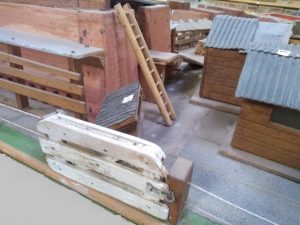Longmead Brickworks
A brick made from the Longmead Brickworks (LBW)
Photo of Charlie Elkins, with his model of the Longmead Brickworks 1825-1950.
Also pictured are the Eastleigh Carnival Queen & Princess and the Reverand Gordon Rose.
Photo taken in 1982.
This model is now at The Brickworks Museum, (also known as Bursledon Brickworks) in Swanwick, Hampshire. The UK’s sole surviving Victorian steam-driven brickworks. https://thebrickworksmuseum.org/
In the 1982 photo, there is a numbered guide to the Brickworks (unfortunately now missing)
Numbers 1 & 2 look like tool sheds.

Numbers 1 & 2 side view

This Ordinance Survey photo of Longmead Avenue in 1948, shows these sheds.

Number 3 looks like a lean to shed with a wooden board ramp.
Number 3 side view with bench.

Number 4

Number 4

Number 5

Number 6

Number 6 side view

Number 7

Number 8

Number 9

Number 10

Number 10


Longmead Brickworks

Number 11

Number 12


The Longmead Brickworks sheds are shown in the middle of this photo.
Between St. Mary’s Church and the end of St. Mary’s Road.
Brickyards are recorded on part of what was the Longmead Estate from the early 1900s. Longmead Brickworks supplied bricks for many of the houses in Bishopstoke. Houses in Longmead Avenue, Edward Avenue and Drake Road were built from bricks made on the old Longmead Estate. As the clay was worked out and houses built, the brickworks were moved eastwards to the next area. Brickworks existed here until the 1940s and what we know to-day as Rogers Road was not built until the late1950s. The area in the north of the village, between Church Road and Stoke Park Woods was the scene of brickmaking activities for much of the first half of this century, as clay abounds in the area. The clay was dug and the kilns in which the bricks were fired were established on the site. As the clay was worked out the brickworks were moved eastwards to the next area. Mr Charles Elkins described these activities. “In the area north of St Mary’s Road, Nelson Road and what is now Rogers Road clay was dug for brick making and there were kilns sited in the area where the clay was dug. These bricks were used by the builder, E H White and Sons of Newtown Road, Eastleigh, for the houses in Longmead Avenue. I worked on the cutting out of Longmead Avenue, which was done by pick and shovel. Edward Avenue was built after this by Blake Brothers, builders from Totton” Mr. Ivill also had memories of the brick making activities in Bishopstoke, “As a boy I worked in the brickyard which was where Rogers Road is now. The clay was dug out of the ground and worked with water and breeze, then left overnight. At 4:o’clock next morning it was put on a bench where the brickmaker put it into a mould and left it to dry. Then it was baked in the kiln”. Mrs Durrant, born in 1921 in St Mary’s Road, has rather different memories of the brick kilns. “I used to walk to school through the backway to Church Road. It was a cinder path, from the brick kilns. The men used to dig the clay with pickaxes and shovels. The Plantation at the back of Edward Avenue was wider in those days and we used to go there and get the chestnuts off the trees. Old Mr Hall, he used to fire the brick kilns and he would put the chestnuts on a long shovel and put it in the kiln. When roasted, he would pull the chestnuts out for us.
. 
LOCATIONS OF THE BRICK KILNS

James Richard Elkins


Longmead Avenue is named after the Estate to which the land once belonged, it was built on the site of an old brickworks. At the Western end, it was bound by a bank that extended from St. Marys Church to the top of Church Road. The entrance to the brickworks was via a track, which ran just North of the Church and before what is now the junction with Longmead Avenue. You can still recognise where it was today, between the Church and at the back of the Longmead flats on the corner of Longmead Avenue.
Gallery (Click on an image to enlarge)












